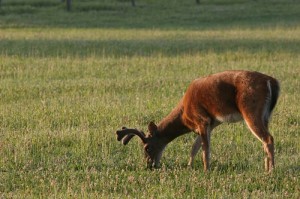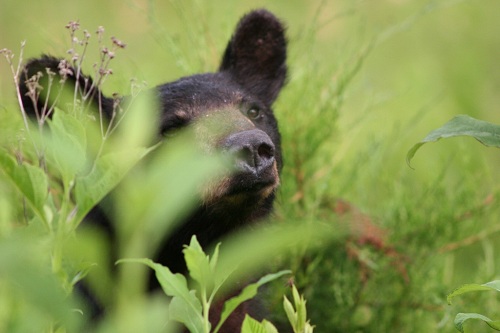No matter what part of the Great Smoky Mountain National Park you’re visiting, don’t approach the wildlife! Though they may be cute and make for a great Facebook post the closer you get, extreme caution should always be the play. One reason – you don’t want to alter an animal’s behavior, or they might try to alter yours. Now then, here’s a quick rundown of wildlife you might come across in Townsend, the Smoky Mountains, and especially Cades Cove.
You’re very likely to see a black bear in Cades Cove, maybe even more so than any other place in the park. The bears are most likely to be seen spring through the fall as they become very sleepy in the winter, becoming semi-hibernating. The Smoky Mountain black bear is not as dangerous or as large and aggressive as the Grizzly.
Bobcats are nocturnal and rarely seen in Cades Cove or other parts of the Great Smoky Mountain National Park, but they’re there. Bobcats weigh eighteen to twenty pounds and are about three feet in length. They prey on fawns and other small game.
Both red and gray foxes are found in the Great Smoky Mountain National Park and both prefer Cades Cove to just about any other place in the park. The reason for this is the availability of both forest and open fields. The trees in the cove also provide foxes with added protection from coyotes and other predators.
Coyotes help control small animal populations of Cades Cove. Coyotes are dog-like in appearance but with noticeably smaller feet, thinner legs and a bushier tail. They are about two feet tall and four feet log including their tail. Their facial features are distinctive, having pointy ears, round inquisitive eyes and an overall appearance that looks a bit like a German Shepherd.
Skunks are common in Cades Cove, both striped and spotted, with their highly recognizable bushy tail. Their ability to potentially spray their foul smell at unwelcome guests keep most people away even at the sight of one. Skunks can spray a distance up to fifteen feet.
Covered with waterproof brown fur, except for their tail which is black and hairless, and weighing up to 60 pounds, the beaver is an interesting species. The beaver’s legs are fairly short with clawed partially webbed feet in the front and fully webbed feet in the rear. They prefer slow wide waters which are near trees.
Raccoon are charming creatures, but nocturnal. These masked animals will eat anything they come across in the park, and anyhting you might leave as well. They’re very intelligent and often found in the dense forests that are near water. Raccoons make their dens in hollow trees, abandoned buildings, or dens abandoned by other types of animals.
 Beautiful and shy, it’s rare to see a red wolf in Cades Cove. They are very sly and usually aren’t to be found close to people.
Beautiful and shy, it’s rare to see a red wolf in Cades Cove. They are very sly and usually aren’t to be found close to people.
Seen as pests by most farmers, Woodchucks would eat farmers crops in Cades Cove centuries ago and dig holes. This practice could injure the legs of various farm animals if they stepped in a burrow.
All of the Great Smoky Mountain National park is a haven for white tailed deer, but there is no better place to view deer than Cades Cove. Smokies visitors commonly see 200 deer if visiting the cove at sunrise. Though timid, the deer have learned to tolerate motorists stopping along the Cades Cove loop to watch them browse.
Wild Boars are present in Cades Cove but are not native.
There are many types of snakes in Cades Cove but only two, the Copperhead and the Timber rattlesnake are poisonous. Bites are rare but it is a good idea to be wary of night hiking when the snakes are most active or of climbing around piles of rock, tall grass, abandoned buildings, etc.
There are over 200 species of birds in Townsend and Cades Cove. Summer birds include yellow warblers, indigo buntings, eastern kingbords and barn swallows. Golden eagles visit Cades Cove in the autumn. In addition there are night flying barred owls, pileated woodpeckers, red-winged blackbirds, meadowlarks, sparrows, bluebirds, red-tailed hawks, wild turkeys, crows, and mourning doves.
